I’ve just finished Sebastian Mallaby’s new biography of Alan Greenspan (The Man Who Knew: The Life and Times of Alan Greenspan). Highly recommended. Greenspan was (and is) a fascinating and often enigmatic character—a mostly self-taught economist; a jazz musician; a skilled political operator and policy adviser; a socialite and lady’s man; a connoisseur of economic arcana; and, of course, the Maestro for more than 18 years at the helm of the Federal Reserve. Mallaby does a great job telling Greenspan’s story, including his eventful pre-Fed years—Greenspan was 61 when President Reagan appointed him to the Fed—and he provides a sympathetic and nuanced account of his long career. This book is not just for Fed-watchers—anyone with an interest in postwar U.S. economic and political history will enjoy The Man Who Knew.
This post is not a book review, though. I want instead to comment on Mallaby’s overall assessment of Greenspan—most especially, the Chairman’s responsibility for the 2007 financial crisis. That assessment is important for Greenspan’s reputation, of course, but it also matters for the lessons that future policymakers should take from that disastrous episode. Although Mallaby makes some interesting arguments, I think in the end his evaluation does not ring true psychologically or fit well with the book’s own themes. And it carries, I think, some questionable implications for future policy.
Mallaby’s assessment of Greenspan
In general, Mallaby’s depiction of Greenspan is carefully drawn and well balanced. His strongest praise is reserved for Greenspan’s intellectual gifts: “As an observer, analyst, and forecaster, he was formidable,” he writes.[1] He gives plenty of space to Greenspan’s famous call of the mid-1990s, that U.S. productivity growth was higher than initially captured in the economic statistics, an insight that would become the centerpiece of Bob Woodward’s earlier Greenspan biography, Maestro. “But the truth is,” Mallaby writes, “that Greenspan’s less remembered pre-Fed judgments [for example, during his time as a White House adviser] were equally prescient.” In short, Greenspan was “the man who knew.”
A careful biographer, Mallaby takes on straw-man characterizations of his subject. He is particularly effective in debunking the conventional view that Greenspan—an acolyte, in his youth, of the libertarian philosopher Ayn Rand—was a free-market ideologue who was blinkered to the risks of financial instability and reflexively opposed to all financial regulation. Although Greenspan never completely shed his early libertarian tendencies, he evolved considerably over his long career. As Mallaby documents, Greenspan’s successful stints in the worlds of business and politics made him increasingly pragmatic and empirical, perhaps even elastic in his beliefs. He had a practitioner’s instinct for the vagaries of financial markets, and he understood better than most economists that markets can exhibit bouts of “irrational exuberance,” the phrase he famously used in his 1996 speech. Perhaps most tellingly, Greenspan never espoused a policy of benign neglect of financial risks during his time at the Fed; instead, starting with the October 1987 stock market crash in the early months of his term, he stood ready to use the Fed’s lending, supervisory, and monetary powers as needed to protect the financial system and the broader economy from bouts of financial instability.
As Mallaby shows, Greenspan’s views on financial regulation were complex. It’s true that he was, generally, more trusting than not of market outcomes. For example, like many of his contemporaries, he was inclined to believe that the financial innovations of the 1990s and early 2000s—such as increased use of exotic derivatives and securitizations—were stabilizing on net, because they deconcentrated risk. (In this he differed from Paul Volcker, who famously suggested that the only recent worthwhile financial innovation was the automatic teller machine.) He was also skeptical of the ability of outnumbered and outgunned bank supervisors to constrain risk-taking at large financial institutions; he preferred instead to rely on minimum capital requirements, which (he believed) would force banks to bear the consequences of their own risk-taking and thus to choose a reasonable balance of risk and reward. Overall, in retrospect, Greenspan was clearly too sanguine about the self-regulating properties of credit markets—a point he would acknowledge in Congressional testimony after the crisis. However, contrary to the stereotype, Greenspan was not inflexibly opposed to tougher rules and oversight of financial activities. He rarely resisted regulatory initiatives put forth by the Federal Reserve Board staff, for example, and on at least a few occasions he publicly advocated stronger financial regulation—Mallaby cites in particular Greenspan’s concerns about the government-sponsored enterprises, Fannie Mae and Freddie Mac, and his support for enhanced auditing standards after the Enron scandal.
The multiple influences on Greenspan’s regulatory views are nicely conveyed in Mallaby’s recounting of two famous episodes involving, respectively, Brooksley Born of the Commodity Futures Trading Commission and Ned Gramlich of Greenspan’s own Board. Born’s advocacy of expanded derivatives regulation and Gramlich’s support for tougher restrictions on subprime mortgage lending were both opposed by Greenspan (and, in Born’s case, also by Robert Rubin and Larry Summers of the Clinton Treasury). In retrospect, of course, Born and Gramlich were (largely) right and Greenspan was wrong. What Mallaby shows, however, is that the debates over their proposals were not the black-and-white ideological clashes they are often made out to be, but rather involved a range of personal, political, and policy considerations, consistent with Mallaby’s less ideological portrait of Greenspan.
So, Mallaby has disposed of the caricature of Greenspan as a rigid, free-market libertarian, painting him instead as an independent and perceptive thinker. In particular, much more so than most economists, especially academics, Greenspan was willing to entertain the possibility that financial markets could go seriously off the rails. This leaves the author, though, with a bit of a problem: If Greenspan was not ideologically constrained, and if he was “the man who knew” the dangers posed by financial instability, why didn’t he do more to prevent the building risks that culminated in the 2007 financial crisis?
Mallaby’s explanation emphasizes psychological, rather than analytical, failures on Greenspan’s part. He argues that, despite Greenspan’s great acuity on economic and financial matters, his record as a “doer rather than an observer…was not so distinguished.” The root of the problem, in Mallaby’s view, lay in Greenspan’s passive personality: “Despite his extraordinary prestige, Greenspan knew he could survive in Washington only by avoiding fights, or by engaging in them passively and deviously. It was an approach that came naturally to a sensitive, shy man. Haunted by the absence of a pale father, intimidated by the presence of a vivid mother, he often lacked the confidence to confront others personally and directly.”
In particular, according to Mallaby, it was Greenspan’s personality more than his philosophy that prevented him from trying harder on the regulatory front: “Greenspan made the…pragmatic judgment that fighting for new regulation would be politically impossible. It would mean forging a united front among multiple regulatory bodies, and it would involve battling powerful lobbies that had the ear of Congress. With his reflexive passivity, Greenspan had no stomach for this fight…He was first and foremost a political survivor. He wanted to make friends, not alienate them.”
If Greenspan had only been personally tougher and more determined, could he have made a real difference in the effectiveness of pre-crisis financial regulation? “The best guess,” Mallaby writes, “is that he would not.” The political barriers to meaningful new regulation really were too great, Mallaby judges. Even though Greenspan was the Maestro, “there were limits to his power…He was maneuvering in cramped political terrain, boxed in by a clamorous multitude of turf fighters and string pullers and influence peddlers. If he often behaved passively, it was partly because he was hemmed in by these constraints.” Ultimately, then, Mallaby’s verdict on Greenspan’s regulatory policy is not guilty, since “with limited power comes limited responsibility.”
However, in Greenspan’s other principal domain of monetary policy, Mallaby comes to the opposite conclusion. Unlike regulatory policy, where Greenspan was hemmed in by politicians and other regulators, in the setting of short-term interest rates Greenspan “exercised untrammeled power.” Mallaby concludes that Greenspan can therefore be held culpable for not using his control of monetary policy to prevent the buildup of financial risks. Most importantly, Mallaby argues, Greenspan should have kept policy tighter than he did during 1998-99 and 2004-2005, to fight the tech bubble and the housing bubble, respectively.
Why didn’t Greenspan do more to lean against the bubbles? Although Mallaby is willing to allow a role for simple misjudgment, he once again wants to pin most of the blame on Greenspan’s passive personality. The status quo for monetary policy, which involved targeting consumer price inflation, was comfortable, something that Greenspan understood well, he argues. The alternative, using monetary policy to stabilize the financial system, “was too awkward to live with. If [Greenspan] had tried to make bubbles and leverage a central part of his mission, the Fed’s mandate from Congress, requiring it to focus on inflation and employment, would have needed revision. Likewise, the expectations of politicians and the public, which created the enabling environment around the Fed, would have required reshaping. For a man who was averse to picking unnecessary fights, it was all too daunting…. In short, Greenspan knew that financial instability mattered. But he focused instead on inflation for a simple and not entirely good reason. Controlling asset prices and leverage was hard; fighting inflation was easier.” Greenspan may have been the man who knew, but, Mallaby says, he lacked the resolve to use that knowledge in a way that might have made a difference, by using monetary policy aggressively to contain potential bubbles.
My take
As I’ve said, I really like the book. But I have problems with Mallaby’s bottom line on his subject, on both substantive and psychological grounds.
On the substance, Mallaby’s argument relies heavily on the propositions that 1) as a practical matter, primarily because of political constraints, more effective financial regulation was impossible in the years before the crisis; and that, accordingly, 2) monetary policy could and should have been used in 2004-2005 to deflate the housing bubble and avert the subsequent financial collapse. Both of these contentions are, well, contentious, and this book does not add much to long-running debates.
On regulation, it’s true that the overall direction at the time (both within the U.S. and internationally) was toward a “lighter touch” in financial rules and oversight, and that any efforts to significantly tighten up regulation were likely to face political resistance. For example, as Mallaby discusses, Greenspan was frustrated by the lack of Congressional response to his early and frequent warnings about the government-sponsored enterprises, Fannie Mae and Freddie Mac. Supported by both banks and the housing industry, and with huge profits available to use to advance their political goals, the GSEs were basically untouchable in the years before their shocking demise in 2008.
However, although the political forces blocking GSE reform were indeed powerful, there were other ways in which a counterfactual Greenspan—one convinced that tougher financial regulation was necessary—might have had a meaningful effect. First, if he had chosen to do so, the Chairman could have leaned, in public and in private, against the deregulatory trends of the late ‘nineties. A number of the issues were hotly contested, and it’s not impossible that his intellectual leadership and prestige could have influenced the outcomes of debates on (for example) bank capital rules and derivatives regulation, at least on the margins.
Second, more concretely, during this period the Fed already had in hand regulatory authorities in banking supervision and consumer protection. (There is implicit self-criticism here, since I was on the Board of Governors from late 2002 to early 2005.) To be sure, as I discuss in chapter 5 of my memoir, The Courage to Act, these authorities were not immune to political influences. For example, political blowback from community banks (smaller and closer to Main Street than their big Wall Street cousins) and their Congressional allies delayed the issuance of supervisory guidance on commercial real estate loans, and political concerns about preserving “legitimate” subprime lending (which was seen as providing lower-income people and members of minority groups the opportunity to become homeowners) contributed to excessively cautious rulemaking on mortgages. Moreover, regulatory fragmentation posed practical challenges, e.g., a large fraction of dubious subprime loans was made by lenders not supervised by the Fed or other federal regulators. Still, the Fed’s regulatory authorities in supervision and consumer protection were fairly broad, and they did not require further authorization by Congress or other regulators. With the very substantial benefit of hindsight, these tools could probably have been used more aggressively to tackle not only bad mortgage lending but also risky banking practices, like the proliferation of off-balance sheet vehicles and poor liquidity management. In short, it would have been asking a lot of Greenspan—given his own inclinations and the prevailing intellectual winds—to have taken a more proactive regulatory stance in the years before the crisis. But it’s too strong to argue, as Mallaby does, that a meaningfully tougher regulatory policy was completely infeasible.
On monetary policy: This is not the place to re-litigate the long-running debate on whether, in setting short-term interest rates, central banks should give heavy weight to financial stability concerns. (I discussed monetary policy and the housing bubble here; see also this blog post and chapter 5 of my memoir.) The view held by most policymakers today, which I believe to be correct, is that under most circumstances, monetary policy is too blunt a tool to use for controlling asset bubbles; consequently, it should not be used in that way (if at all) until more-targeted regulatory and supervisory approaches have been exhausted. Mallaby does not really engage the debate, except rhetorically: For example, he derides as “just an assertion” the argument that interest-rate increases large enough to pop a large bubble would also cause serious macroeconomic damage. However, quantitative cost-benefit analyses of the potential use of monetary policy to tackle asset bubbles have tended to find that the cost (the direct effect of higher rates on employment and inflation) greatly exceeds the putative benefits (a possible reduction in the risk of a crisis); see, for example, recent work by Andrea Ajello et al. and by Lars Svensson.
More concretely, Mallaby’s argument that Greenspan should have known that a tighter monetary policy was appropriate in 2004-2005 (if that was in fact the case!) strains credulity. In 2003 the Fed was navigating a deflation scare and a jobless recovery from the 2001 recession—no net payroll jobs were created in the U.S. economy over 2003—which had led the Federal Open Market Committee to cut the fed funds rate to a record-low 1 percent. The FOMC did not stay at that level for long, however; Greenspan began to prepare the ground for a rate increase in January 2004, when the Committee’s language about keeping policy accommodative for a “considerable period” was modified. As Brad DeLong has pointed out, citing the FOMC transcript, at that point Greenspan was far from certain that the rise in housing prices was a nationwide bubble or that it could pose a threat to financial stability. Indeed, much of the increase in housing prices was still to come: According to the Case-Shiller 20-city index, house prices, which had risen 12 percent in 2003, would rise an additional 16 percent in 2004 and 15 percent in 2005 before peaking in early 2006. After Greenspan’s signaling, the Fed began a well-anticipated rate-hiking campaign in June 2004, at which point the unemployment rate was still 5.6 percent. The FOMC would go on to raise the federal funds rate at seventeen consecutive meetings.
With that background, how much credence should we give to Mallaby’s argument that Greenspan’s personality – the product of an absent, “pale” father and the presence of a “vivid” mother – was the basis of his monetary policy choices? It seems awfully implausible to me. People in Greenspan’s position (I can say, with some authority) put great weight on their reputation and legacy—how they will be regarded even after they leave office. Mallaby’s assessment of Greenspan rests on his contention that relatively modest changes in monetary policy, notably in 2004-2005, would have significantly reduced the risks of a destructive financial crisis, doing so without significant macroeconomic side effects in the near term, and that Greenspan should have recognized that. “In both instances,” Mallaby writes, “unemployment was low, deflation was not threatening, and yet markets were evidently too hot.” Not obviously true in early 2004, when Greenspan signaled tighter policy. If Greenspan had really believed that such a favorable tradeoff was possible, concern for his legacy would have led him to act; and presumably he could have taken the FOMC in that direction, without changing the Fed’s mandate or facing unbearable political pressure, as Paul Volcker had demonstrated in his difficult and protracted battle against inflation.
The reason that Greenspan took the monetary actions he did, I am sure, is because at the time he thought they were the best policy. He was far from sure that the increase in house prices posed a danger that could not be managed; he would have been skeptical about the Fed’s ability to pop a bubble, at least not without large collateral damage; and he surely did not anticipate that losses in mortgage markets would touch off a global liquidity panic, which arguably made the crisis and its economic effects much worse. In any case, the tightening cycle that began in June 2004 was arguably the most aggressive of any since the early 1980s. Perhaps Greenspan and the FOMC should have tightened even more quickly—we are still debating the issue, more than a decade later—but the fact that the pace of rate hikes in 2004-2005 was not sufficient to stop house price increases does not fit well with the view that minor tweaks in monetary policy would have done the job.[2]
I find Mallaby’s psychological hypothesis puzzling, not only because it is at best weakly supported, but also on Occam’s Razor grounds—it’s not necessary to explain Greenspan’s policy choices. Indeed, The Man Who Knew provides us, in its narrative, a much better motivation for Greenspan’s approach—namely, his experience, as Fed chairman, in dealing with periods of financial instability. As Mallaby documents, Greenspan responded to each episode of instability during his chairmanship—the 1987 crash, the 1990s credit crunch, the Asian crisis, the collapse of Long-Term Capital Management, the Russian default, the tech bubble—either through direct measures (such as standing ready to lend through the discount window following the 1987 stock crash, or the negotiations that saved LTCM in 1998) or through monetary policy responses after the fact. Greenspan would have seen all these episodes as successful, in that none involved serious damage to the broader economy. Perhaps the financial crisis during Greenspan’s term with the greatest macroeconomic impact was the collapse of the tech bubble, which was the main source of the relatively mild 2001 recession. Whether the monetary policy response to that recession was successful is in the eye of the beholder; the relevant point is that Greenspan, the FOMC, and those who adulated Greenspan at the Jackson Hole conference in 2005 believed that it was. The factors that would make the 2007 crisis so unprecedentedly catastrophic, including the collapse of key funding and securitization markets, were not foreseen.
As Mallaby shows, Greenspan believed that financial instability poses significant risks, and that belief was reflected in his policies. But as he contemplated his monetary policy choices in 2004-2005, he had every reason to think that targeted measures or after-the-fact monetary responses could limit the consequences of financial stresses on the broader economy. That Greenspan’s policies were conditioned by his experiences in coping with financial instability as Fed chairman seems the right conclusion to draw from Mallaby’s interesting biography.
[1] All quotes are from Mallaby’s concluding chapter, “The Blind Roller Skater,” pp. 672-86 of The Man Who Knew.
[2] See Bernanke (2010). This study found that controlling the boom-bust cycle would have required the Fed to raise interest rates by eight percentage points. Another common argument is that the steady pace of rate increases was destabilizing. There is limited theoretical rationale for that view, and in any case Greenspan’s experience was that irregular and hard-to-forecast rate changes, like those that triggered the bond crash in 1994, are more likely to be destabilizing.
Comments are now closed for this post.

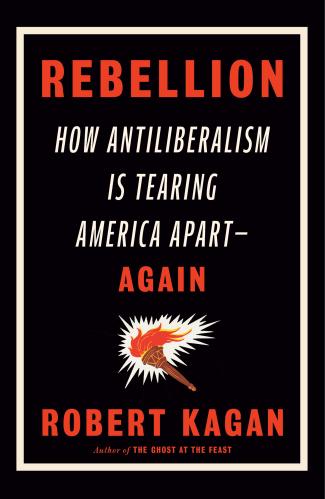
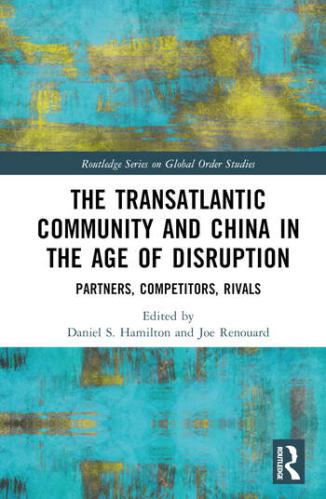
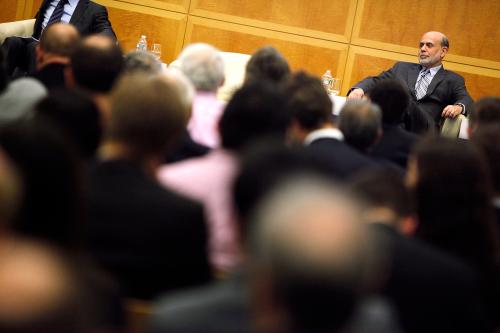

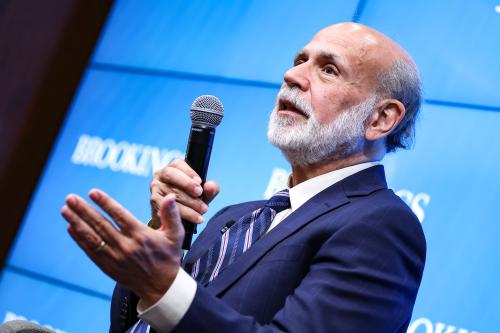
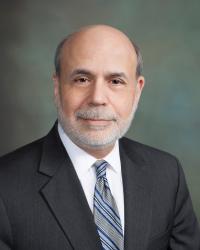
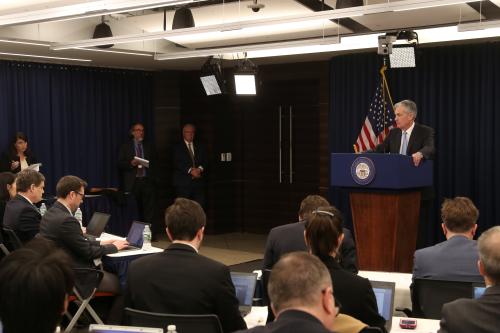
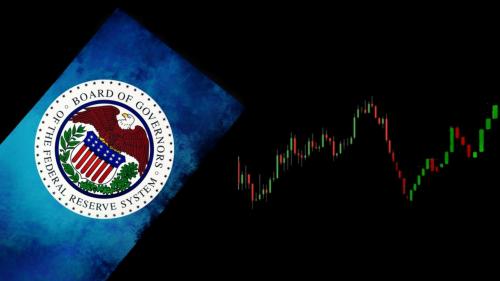

Commentary
Sebastian Mallaby’s biography of Alan Greenspan
November 3, 2016